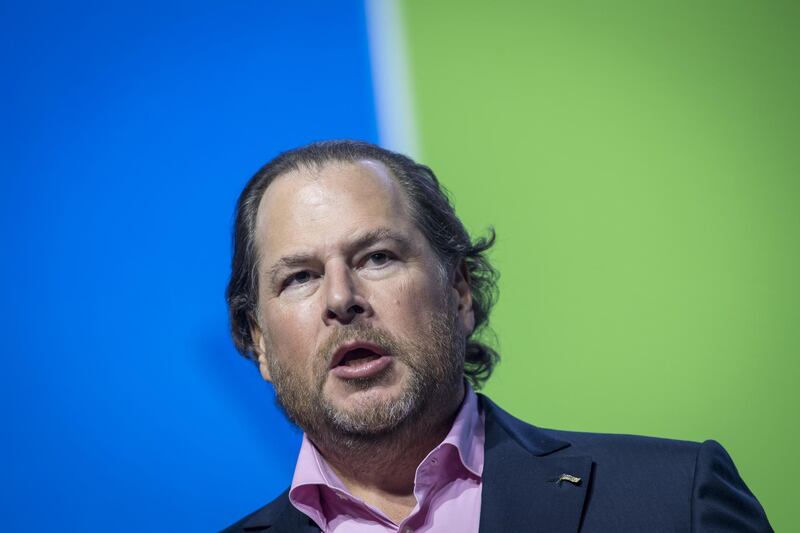Salesforce.com founder Marc Benioff and his wife Lynne agreed to acquire Time magazine from Meredith Corporation for $190 million (Dh679.7m) in cash, launching the colourful 53-year-old entrepreneur, who helped lead the shift in software to an on-demand model, into a new role: media baron.
He joins an elite group of US pioneers who have moved from start-up to multi-billionaire in a few short years, such as Amazon founder Jeff Bezos and Mr Benioff's old boss at Oracle Larry Ellison, not to mention Facebook's Mark Zuckerberg and others. Indeed, as a newly minted media tycoon, he has mirrored Mr Bezos' purchase of The Washington Post in 2013 and another billionaire, Patrick Soon-Shiong, a healthcare entrepreneur, who this year bought The Los Angeles Times for $500m.
Mr Benioff is worth an estimated $6.5 billion, a lot less than Mr Bezos' $162bn, Mr Ellison's $55bn or Mr Zuckerberg's $64.3bn, according to the Bloomberg Billionaire's Index, but certainly a pile not to be sniffed at.
Here's how Mr Benioff worked his way through the ranks to stand alongside his fellow US tech giants.
Marc Russell Benioff hails from San Francisco and is something of a rare beast among Silicon Valley CEOs - he was actually born and raised in the San Francisco Bay Area. His father, Russell Benioff, owned a local department store in the city. "I learned my work ethic from him," Mr Benioff once said.
While in secondary school, Benioff Jnr sold his first app called "How To Juggle" for the TRS-80 Model 1 computer - to a computer magazine for $75. Coincidentally, he is distantly related to David Benioff, of "Game of Thrones" fame. At just 15, Marc founded one-man operation Liberty Software, making games for the Atari 800 computer. Titles included "King Arthur's Heir", "The Nightmare", "Escape from Vulcan's Isle", and "Crypt of the Undead".
By age 16, he was earning $1,500 a month, according to Business Insider. After he left school in 1982, he was able to pay his own fees at the University of Southern California. While there, he took a summer internship with Apple, working as a programmer in the Macintosh division under co-founder Steve Jobs. "That summer, I discovered it was possible for an entrepreneur to encourage revolutionary ideas," Mr Benioff would later write. On a USC professor's suggestion, he took a customer support role at database company Oracle straight after leaving university.
His rise was little short of stratospheric.
_______________
Read more:
Salesforce.com founder Marc Benioff acquires Time Magazine
Regulate Facebook like cigarettes, tech billionaire tells governments
_______________
At 23, he was named Oracle's "Rookie of the Year". By 26, he was a company vice president - the youngest person to attain the role in the firm's history. And it came with a $300,000 salary.
While at Oracle, Mr Benioff caught the attention of Mr Ellison, its founder, and they quickly became firm friends. After 13 years with Oracle, Mr Benioff, with a few other Oracle stalwarts, laid the foundations for Salesforce. The firm's unique selling point was that, unlike all the other major players, Saleforce let people access business apps from a web browser. For the late 1990s, this was revolutionary.
At first, Mr Ellison was supportive of Mr Benioff, letting him split his time between Oracle and Salesforce. Mr Ellison even gave Salesforce $2m from his own pocket and sat on its board of directors.
But when Mr Benioff found out Oracle was working on a direct competitor to Salesforce, he tried to force Mr Ellison to quit Saleforce's board. Instead, Mr Ellison forced Mr Benioff to fire him - meaning Mr Ellison kept his shares in Salesforce.
Amid the resulting animosity between the two, both personal and professional, Salesforce survived the dot-com bust of the early 2000s and just kept growing, becoming one of the earliest and biggest companies in the modern cloud computing market.
In June 2004, Salesforce held its IPO, raising $110m at $11 per share. Today, it trades around $140.
Beyond just business, Mr Benioff is a best-selling author of the business book Behind the Cloud, a 2009 memoir on Salesforce's early success.
He is also a big believer in corporate philanthropy: under his leadership, Salesforce invented the "1-1-1" model, where the company gives 1 per cent of employee time as volunteer hours, 1 per cent of its profits, and 1 per cent of its resources to charitable causes.
With this, he shares more common ground with Mr Bezos. Last week, the richest man on the planet announced he was creating a philanthropic fund, the Bezos Day One Fund, to help homeless families and launch preschools in low-income communities, committing an initial $2bn.
It's a path long since trod by Micorsoft's founder Bill Gates, who with his wife heads the Bill & Melinda Gates Foundation, a philanthropic organisation he founded with his own money in 2005. The fund has donated some $36bn to charitable causes since its launch.
Meanwhile, Salesforce has grown to a $40bn company and its annual Dreamforce conference has ballooned to take over much of San Francisco every autumn. In 2018, it opened its Salesforce Tower headquarters in San Fransisco.
Given his penchant for publicity, perhaps Mr Benioff's musings will become a regular feature for Time magazine readers in the near future.






